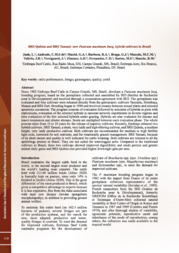BRS Quênia and BRS Tamani: new Panicum maximum Jacq. hybrid cultivars in Brazil.
BRS Quênia and BRS Tamani: new Panicum maximum Jacq. hybrid cultivars in Brazil.
Autoria: JANK, L.; ANDRADE, C. M. S. de; MACIEL, G. A.; BARBOSA, R. A.; BRAGA, G. J.; MACEDO, M. C. M.; VALÉRIO, J. R.; VERZIGNASSI, J. R.; ZIMMER, A. H.; FERNANDES, C. D.; SANTOS, M. F.; SIMEÃO, R. M.
Resumo: Since 1982, Embrapa Beef Cattle in Campo Grande, MS, Brazil develops a Panicum maximum Jacq. breeding program based on teh germplasm collected abd assembled by IRD (Institute de Recherche pour le Developpment) and received through a cooperation-agreement with IRD. The germoplasm was evaluated and four cultivars were released directly from the germplasm: cultivars Tanzânia, Mombaça and BRS Zuri. Breeding began in 1990 and involved crosses between sexual plants and selected apomictic accessions. The program consists of evaluation followed by selection of hybrids in plots with replications, evaluation of the selected hybrids in national network experiments in diverse regions and then evaluation of the few selected hybrids under grazing. Hybrids are also evaluated for disease and insect resistances and abiotic stresses. Seeds are multiplied between each evaluation phase. The whole process takes from 10 to 20 years for the release of superior cultivars. Recently, Embrapa released two hybrid cultivars. BRS Tamani, a short, very leafy and high-tillering cultivar, and BRS Quênia, a medium height, very leafy productive cultivar. Both cultivars are recommended for medium to high fertility light soils, corrected for soil nutrients, and for rotationally grazed management. BRS Tamani, because of its short stature and quality is well indicated for cattle weaning. Both cultivars are tolerant to all the spittlebugs present in Brazil. They are not suited for waterlogged soils. Compared to the traditional cultivars in Brazil, these two cultivars showed improved digestibility and crude protein and greater animal daily gains and BRS Quênia also provided higher liveweight gain per area.
Ano de publicação: 2021
Tipo de publicação: Artigo em anais e proceedings
Unidade: Embrapa Gado de Corte
Palavras-chave: BRS Quênia, BRS Tamani, Capim Colonião, Características genéticas, Cattle performance, Disease resistance, Fitomejoramiento, Forage, Forage grasses, Forage yield, Genetic traits, Germoplasma, Germplasm, Gramínea Forrageira, Guineagrass, Megathyrsus maximus, Melhoramento Genético Vegetal, New variety, Nueva variedad, Panicum Maximum, Pastos forrajeros, Pest resistance, Plant breeding, Rendimento, Rendimiento del forraje, Resistencia a la enfermedad, Resistencia a las plagas, Seleção Genética, Variedade Resistente, Yield
Observações
1 - Por padrão são exibidas publicações dos últimos 20 anos. Para encontrar publicações mais antigas, configure o filtro ano de publicação, colocando o ano a partir do qual você deseja encontrar publicações. O filtro está na coluna da esquerda na busca acima.
2 - Para ler algumas publicações da Embrapa (apenas as que estão em formato ePub), é necessário ter, no celular ou computador, um desses softwares gratuitos. Sistemas Android: Google Play Livros; IOS: iBooks; Windows e Linux: software Calibre.
Acesse outras publicações
Acesse a Base de Dados da Pesquisa Agropecuária (BDPA) para consultar o acervo completo das bibliotecas da Embrapa.

